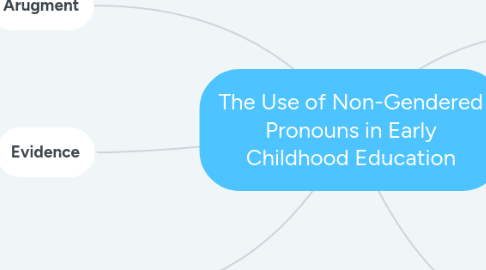
1. Arugment
1.1. Research based
1.1.1. Schools should be inclusive and safe learning environments
1.1.1.1. Teaching non-gendered pronouns helps to avoid using singular they
1.1.1.1.1. Teaching non-gendered pronouns could happen due to federal funding. Federal funding requires public schools to implement certain curriculum and programs in order to receive said funding.
2. Evidence
2.1. 1. Darr, Brandon and Kibbey, Tyler (2016) "Pronouns and Thoughts on Neutrality: Gender Concerns in Modern Grammar," Pursuit - The Journal of Undergraduate Research at the University of Tennessee: Vol. 7: Iss. 1, Article 10 I plan on using this source to define terms relevant to my paper. I also plan on using this article to support my arugment.
2.1.1. 2. Gustafsson Sendén M, Bäck EA and Lindqvist A (2015) Introducing a gender-neutral pronoun in a natural gender language: the influence of time on attitudes and behavior. Front. Psychol. 6:893. doi: 10.3389/fpsyg.2015.00893 I plan on using this source to discuss people's attitudes on the issue and to back my argument.
2.1.1.1. 3. Harris, Chelsea A. MD*; Blencowe, Natalie BMBS, PhD†; Telem, Dana A. MD, MPH*,‡ What is in a Pronoun?, Annals of Surgery: December 2017 - Volume 266 - Issue 6 - p 932-933 doi: 10.1097/SLA.0000000000002505 I plan on using this source to further support my argument. This article can help me to provide insight on the kind of impact my issue has on education.
2.1.1.1.1. 4. MacNamara, J., Glann, S., & Durlak, P. (2017). Experiencing Misgendered Pronouns: A Classroom Activity to Encourage Empathy. Teaching Sociology, 45(3), 269-278. Retrieved March 16, 2021, from http://www.jstor.org/stable/26429227 I plan on using this article to discuss the curriculum the should be implemented surrounding non-gendered pronouns.
3. Conclusion
3.1. In conclusion, teachers will soon (and should) be required to teach their students about non-gendered pronouns. Teaching non-gendered pronouns promote an inclusive and safe learning environment. It also helps to avoid the use of singular they. This requirement for teaching may happen due to federal funding programs.
4. My opener
4.1. Will be a question for readers to ponder while they are reading my paper or a startling fact. I'm not sure yet which to use as I want something that is going to make the reader really think and reflect while also introducing them to my paper.
5. Thesis Statement
5.1. Teaching students about non-gendered pronouns, particularly early childhood students, is extremely important. Inclusivity is an important part of education. As more people feel comfortable expressing their true selves, teachers will soon be required to teach non-gendered pronouns.
6. Questions for Professor Brown
6.1. 1. What are my weaknesses at this point?
6.1.1. 2. What are my strengths at this point?
6.1.1.1. 3. What are the max amount of sources we can use in our paper?

